Personal productivity when you work from home can be…challenging. Sure, working remotely has its perks, but it also has its downsides, like feelings of burnout, stress, and overwhelm.
If you’ve been feeling any of these symptoms lately, there might be a bigger problem on your hands. But not to worry, we got you! In this article, we’re going through 5 personal productivity tips to help reduce burnout and increase efficiency. Let’s dive in!

Not a video person? No problem! We’ll cover all the major points in this article.
What is personal productivity?
We’ve recently received many questions about personal and professional productivity. We typically don’t cover this topic…so what better time than now to start!
Full disclosure, we are not a productivity channel or brand. (We actually gag at some of the advice “productivity YouTubers” give.) So we’re hoping to provide a different perspective (we’re simply not as perfect as those productivity YouTubers) — starting with our own definition of what it means to be productive.
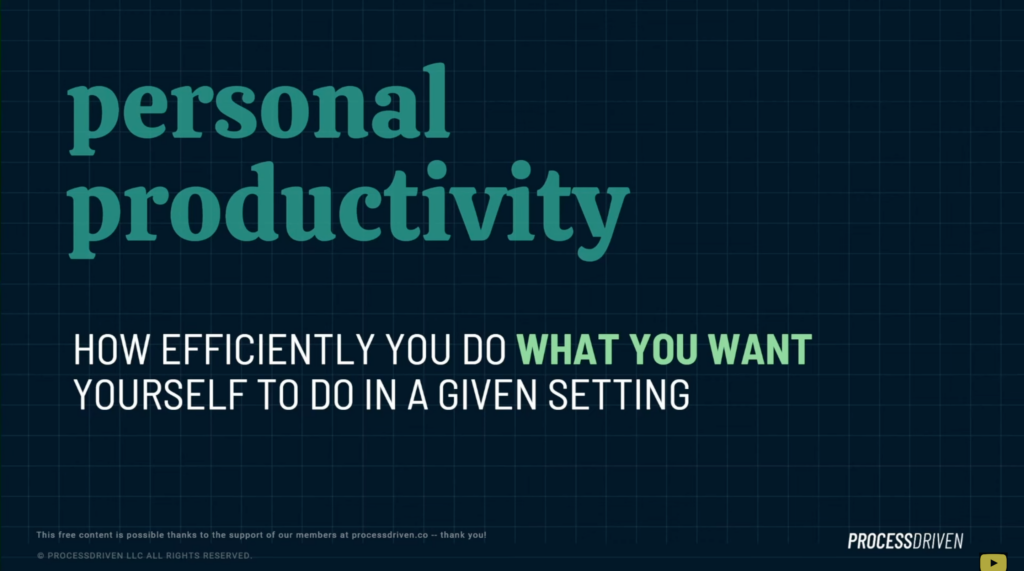
Team ProcessDriven defines productivity as how efficiently you do what you want to do in any given period. By “efficiently,” we mean doing or getting more for the least amount of effort or input.
Personal productivity is not about:
- Doing more
- Making more money
- Hustling
It’s about focusing on what you want to focus on and doing what you want to do. With this definition, an example of personal productivity could look like this:
“I really want to take my Saturday morning to relax. I want to watch TV and do nothing that would be considered “productive” by YouTube standards.“
According to our definition, if we want to relax and then we successfully relax, then that’s being productive. How? Because what we want is to relax and what we’re doing is relaxing.
On the flip side, if we want to get more YouTube videos filmed and we successfully get more videos filmed, that’s also productivity. How? Because what we want is to film more YouTube videos and what we’re doing is filming more YouTube videos.
Simple, right?
Unfortunately, the second example of getting more work done is what most people consider productive. Nonetheless, the five tips we’ll be covering in this article apply to both situations.
Let’s dive into the five tips to maintain this alignment between what we want to do and what we actually do!
To watch this explanation in video format, watch the video at the top of this article at timestamp 00:00.
Productivity Tip #1: Create Time & Space
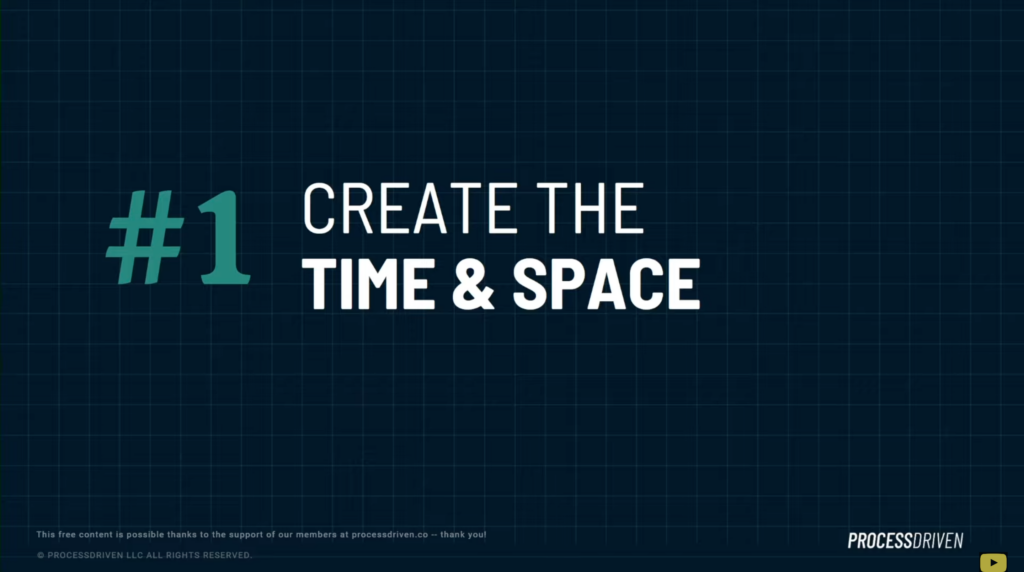
The first tip we have for being more productive is providing time and space for things we’d like to do. This sounds extremely basic but we’ve personally struggled with this one for a while in the past.
Create the time
Let’s start with the first half: creating the time.
We want to put the time aside for whatever’s important to us. We would have to lock that time in our calendar (if we use one) and plan for it.
For example, if we want to become more serious about YouTube content creation, we’d have to think about dedicating a specific time to doing that process. Layla at ProcessDriven currently dedicates every Monday afternoon to the YouTube content creation process. Her top priority is to only work on YouTube videos every Monday afternoon.
Another example would be if we wanted to start strengthening our relationship with our spouse (single folk can skip to the next section), we need aside the time, let’s say every Sunday evening, for date night. We need to make this a routine and stick to it.
Setting aside time for date night or writing your book or whatever it is can feel a bit stifling. If this is supposed to be fun, why do we have to schedule a time?
It’s because we’re starting to build a routine and an expectation that this is important. We want our time (and how we spend it) to reflect our priorities.
If we focus on and block out those important things first, we’re more likely to do them. Again, if productivity is doing what we want to do, let’s make it easier for our future selves and allow the time for what we actually want to do.
CREATE A PRODUCTIVE SPACE, PHYSICALLY!
Let’s move on to the second part of this equation: creating the space.
For many things we do in life, space can be something we set aside. For example, if we want to start getting into journaling seriously, let’s physically create a space to help us do that easily. This can look like having a dedicated notebook, pen, table, and chair in the corner of your room that we can call the “Journal Zone.”
Another example is if we really want to get more into fitness. Let’s create a space for that!
Let’s set aside our shoes, gym clothes, water bottle, and whatever else we need to put in our gym bag and place it right next to our door to create that physical space for that priority.
Both of these scenarios sound cliché, but we struggled with creating a time and space for our priorities for so long because we thought they were super silly. Despite our initial reservations, ProcessDriven and the ProcessDriven YouTube channel are a direct result of implementing this advice.
Layla has a physical space for filming, a dedicated time for filming every week, and the mindset that that process is her top priority at that moment.
We’ll admit that we used to think that keeping up with this tip was going to be impossible but it’s actually gotten easier and easier as the weeks pass.
So as simple as it sounds, create a time and a space to do whatever you want to do (not just work).
You’ll never find time.
A while back, someone gave us some great advice:
“You’re never going to find time. It just doesn’t happen. You need to take the time and make everything else work. Only then will you start to feel a sense of ownership.”
(Shoutout to Michelle for this piece of advice!)
To watch this explanation in video format, watch the video at the top of this article at timestamp 02:53.
Join our FREE Facebook Group to join a community where we discuss all things ClickUp and process-related!
Productivity Tip #2: Prioritize Prioritizing
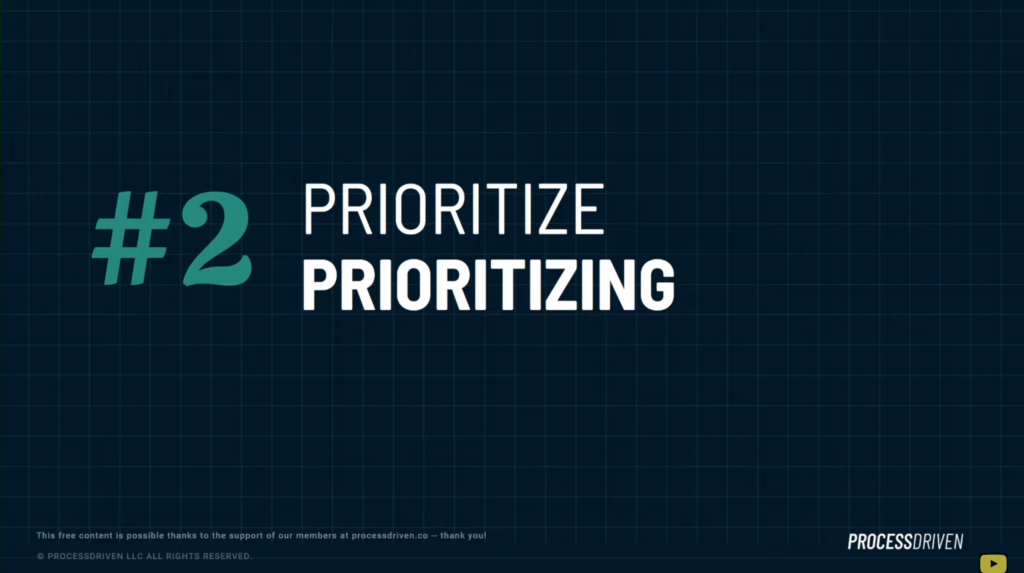
We know this sounds cliché (yet again) but we promise there’s more to this. This tip is mostly about figuring out what’s important to your life.
If the definition of productivity is knowing what you want to do and doing it efficiently, the “knowing what you do” piece of the equation is trickier than it sounds.
Often, business owners think they don’t have any time.
The reality is, that we do have the time, we just mismanage it and spend it on things that don’t really matter. This leads to feelings of unproductiveness because we’re doing something that we think we should do but in hindsight, we shouldn’t have been doing them to begin with.
Take time to decide what matters.
This tip is about taking a moment, preferably every day, to look at everything we have going on. This includes our job, life, family, hobbies, and interests. The question we should ask ourselves is:
What’s the most important thing we need to do today?
Figure that out first. If we move forward in a direction before first figuring out if that’s the right direction, we’re going to waste a lot of time, kill efficiency, and our personal productivity goes out the window.
In the moment, we decide, “It’s just one more hour of work.” But if we take a step back and look at all of our priorities, we might realize something like, “Oh shoot! I should use that hour to walk my dogs because it’s good for my health and they deserve a walk.”
If we get lost in the details of our business, we will lose sight of this and spend time on the wrong things.
Decide before you do.
Take the time to think in chronological order of what is most important. When the first item on the list is done, move on to the next one. This eliminates the, “Am I doing the right thing? What should I do next?” mentality (which is very unproductive).
Decide. Then do. Simple.
We actually have an entire article talking about this tip. Check out How I use ClickUp in my Morning Routine if you want to learn more!
To watch this explanation in video format, watch the video at the top of this article at timestamp 06:38.
Productivity Tip #3: Embrace Chunkiness
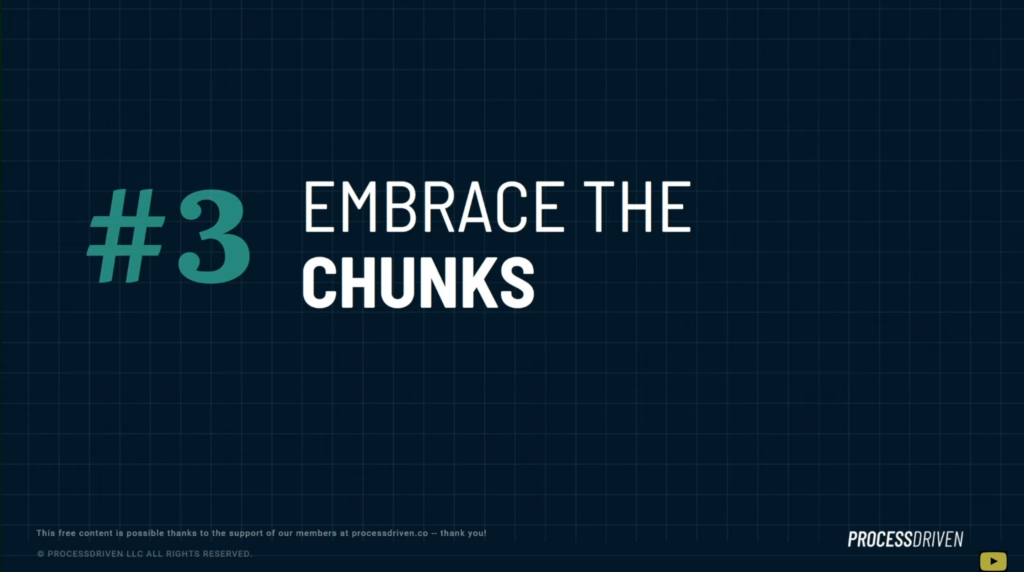
The third tip we have around personal productivity is to embrace chunkiness!
This is another way to think about taking dedicated blocks of time and not feeling like you are rushed or being pulled in multiple directions.
For example, Layla records our YouTube videos every Monday afternoon and sets aside a 4-hour block. She knows that her sole responsibility is to record 1-2 YouTube videos for that entire block of time. If she finishes before the 4-hour block is up, she can do whatever she wants with the remaining time.
By setting aside these dedicated chunks of time for one or two core things you want to accomplish, you can focus on giving those things as much time and space as needed.
Skip the endless to-do list.
We don’t feel rushed and like we have a never-ending to-do list when we set up our work this way. If you have extra time left over after you’re done, yay!
Chunking (or time-blocking) is the opposite of a typical task list. With a task list, we might have a list of 5 things we want to do today and we go through them one by one until we finish. The problem here is we’ll just keep going and going and going…without taking any breaks because there’s always something to do.
Example: Lunch Chunk
A great example of this method is Layla’s Lunch Chunk.
Layla takes a one to 1.5-hour lunch break every day. This is her time to reset. She takes that time to do whatever she wants and usually schedules it right before a very strenuous task. It’s a great way to refresh in the middle of the workday.
To watch this explanation in video format, watch the video at the top of this article at timestamp 09:20.
Productivity Tip #4: Use Palette Cleansers
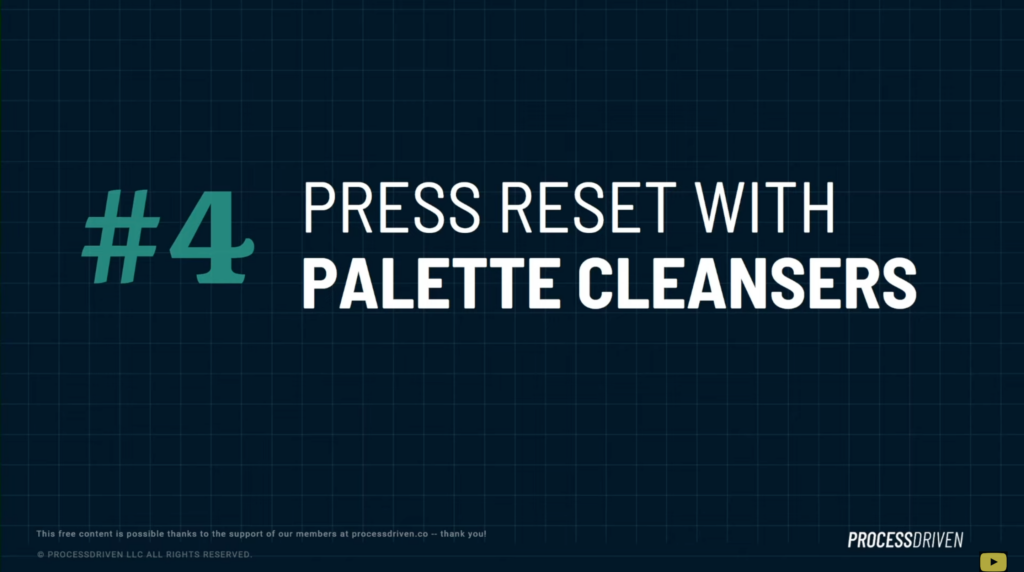
Our fourth tip is to incorporate palette cleansers.
What we mean by this is that rather than focusing on one chunk and another chunk and another chunk and so on, we want you to embrace palette cleansers or things that let our brains and bodies reset between each focus we have.
Let’s say we dedicate a chunk of time to having a date night every Friday with our spouse. Before that date night chunk, we might have some work stuff we need to finish, like writing a blog.
What happens between blog writing and date night? Most people probably do nothing in between. They go straight from work to date night. It’s all just go, go, go.
We’d like you to start incorporating a reset button.
Rituals or Tasks as a Reset Button Between Chunks
So when we’re working on that blog post at the end of our workday and we’re ready to stop working, have some sort of ritual of closing out the workday.
This could be:
- A routine of wiping out the inbox
- Taking a moment to clean our desk
- Turning off our computer and doing a quick stretch
Whatever it is, we just need to incorporate some sort of activity to let our minds reset so we can be present for whatever activity comes next.
This can also be applied to our workday. Let’s say we’re working an 8-hour workday. We might be in meetings from 8AM – 10AM. We should incorporate a palette cleanser between this two-hour block and the next.
Example: Pullups
One palette cleanser Layla likes to incorporate between her work chunks is doing pullups in her home gym. It only takes about two minutes but now her brain and body are reset for the next work chunk. 💪
This separation helps us appreciate the purpose of each moment. We encourage you to try this palette cleanser method out so you can start noticing the difference in your workday.
To watch this explanation in video format, watch the video at the top of this article at timestamp 12:32.
Productivity Tip #5: Listen to Procrastination
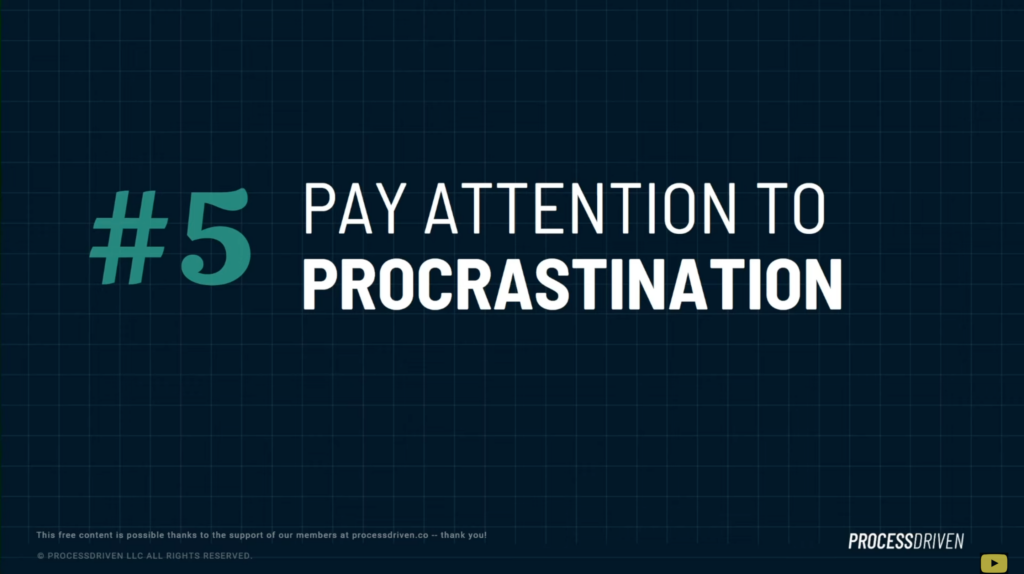
A lot of productivity advice sounds like, “Squash procrastination and just push through! Use all your willpower and brute force if you have to!! Just do it!!!”
I don’t know about you but that hasn’t really worked for us.
Don’t ignore procrastination
Procrastination is a symptom we need to start paying attention to. We shouldn’t be ignoring or “pushing through” procrastination. If we keep ignoring or putting off a certain task, it’s a sign of something bigger.
3 causes of procrastination
Either we think it’s not important, we hate doing it, or we need a break. It doesn’t matter which of these it is, they all signal a problem that procrastination is simply a symptom of.
If we ignore procrastination, we could end up in this cycle of forcing ourselves to go against the grain. While there are times when we do need to push past the procrastination, more often than not, procrastination is something we need to listen to, learn from, and figure out how to avoid.
Procrastination shouldn’t be an issue when we can align what we’re doing with what we want to do and are in the right headspace. If we feel it regularly, something bigger is wrong. Once you correct what’s wrong, you’ll go a long time before you feel like procrastinating again.
To watch this explanation in video format, watch the video at the top of this article at timestamp 15:55.
Why procrastination is actually good, sometimes!
When feelings of procrastination start arising, stop trying. Take a break. It sounds simple but how many of us actually do this?
Nine times out of ten, we were just feeling stressed, overwhelmed, and a bit burnt out.
The next time you’re dreading a task, take a break. Do some dishes, do yard work, fold laundry, play with your dog, stare at the wall and scream — anything that’s going to take your mind off work so you can reset.
Recognize that our brains and bodies know best (so we should definitely listen to them). It’s okay to bend our imaginary rules once in a while if we choose to listen to the signals our bodies give us.
If there’s anything you should walk away with it’s this: you don’t have to listen to our advice or advice you heard on the Internet but you should be listening to the things your brain and body are telling you and find something that works for you.
Until next time, enjoy the process.
Join our FREE Facebook Group to join a community where we discuss all things ClickUp and process-related!
